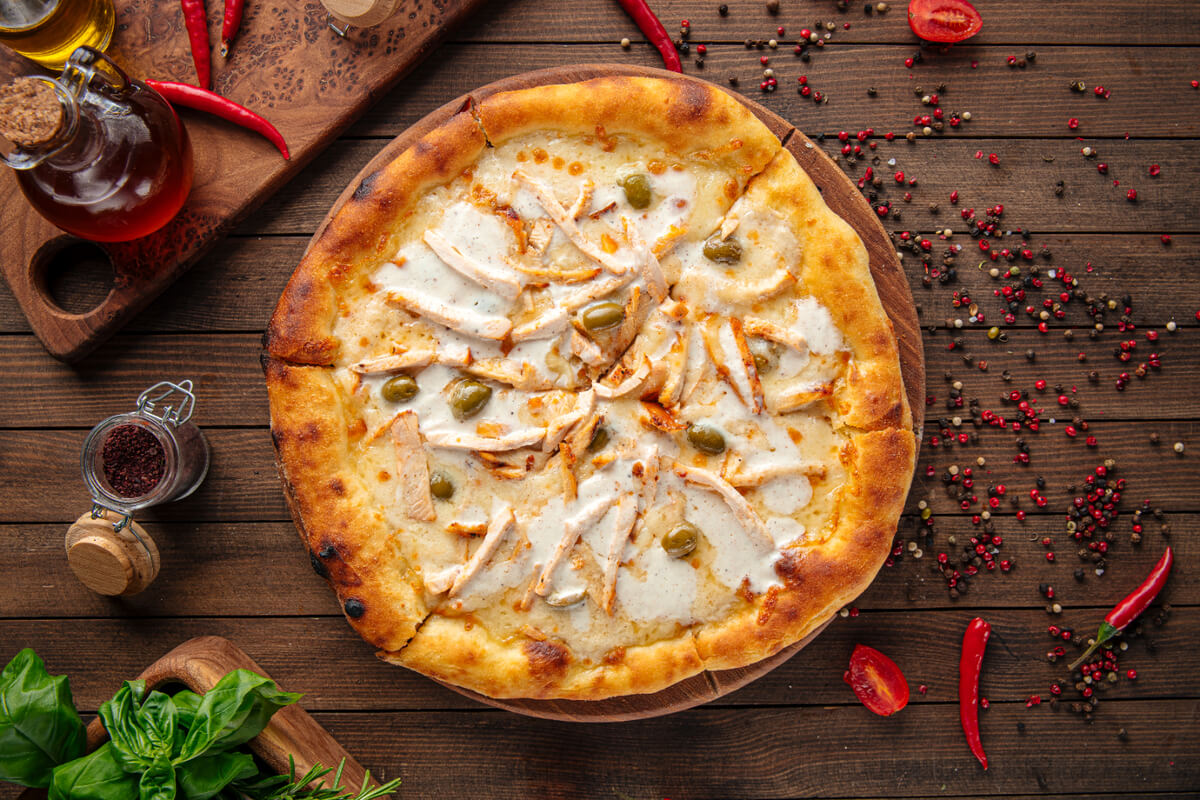Introduction
There’s nothing quite like the satisfaction of homemade pizza. The sizzling cheese, fresh toppings, and the aroma wafting through your kitchen make it a treat that rivals any pizzeria. But imagine pulling your creation from the oven, only to find the crust—your base for all that goodness—soggy and limp. It’s a disappointment that can leave even the most enthusiastic home cooks asking, “Why is my chicken pizza crust soggy?”
A soggy chicken pizza crust can happen for several reasons. From improper cooking techniques and high moisture levels in the chicken to overloaded toppings or incorrect storage methods, a lot can go wrong. But the good news? Each of these issues has a simple fix.
In this article, we’ll explore the most common causes of soggy chicken pizza crusts and provide actionable solutions to prevent them. We’ll also share essential tips for preparing a perfectly crispy crust that holds up to your favorite toppings. After all, the crispiness of a pizza crust is what elevates the overall flavor and texture, giving you that satisfying crunch with every bite.
By following these expert tips, you’ll soon be serving up chicken pizzas with golden, crispy crusts that everyone will love.
1. Common Causes of a Soggy Chicken Pizza Crust
Making a chicken pizza crust sounds like a foolproof way to enjoy a low-carb, protein-packed meal. Yet, sogginess is a common frustration. Let’s explore the main culprits behind a soggy chicken pizza crust and how to avoid them.
1.1 Incorrect Cooking Techniques
One of the biggest mistakes is undercooking the crust or using an oven that isn’t hot enough. A poorly cooked crust remains moist and fails to develop the desired crispiness. Low oven temperatures compound the problem, leaving the moisture in the chicken trapped rather than evaporating as steam.
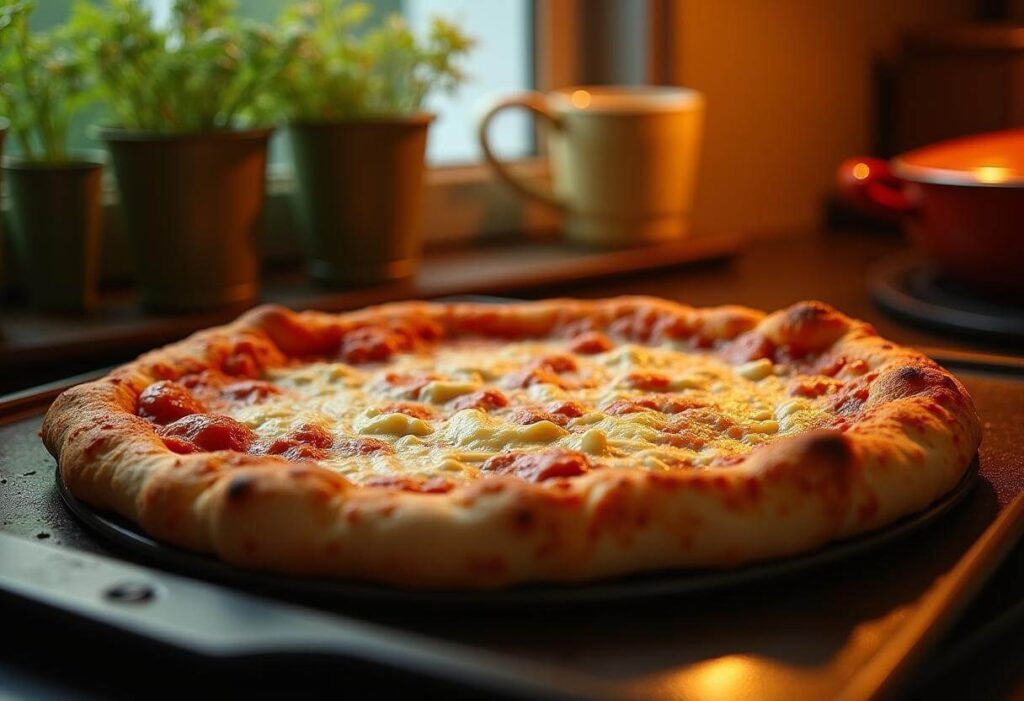
To avoid this, always preheat your oven to at least 400°F (204°C) for chicken-based crusts. Better yet, invest in a pizza stone or steel. These tools distribute heat evenly and help the crust crisp up faster by absorbing moisture during cooking. Preheating the stone or steel along with your oven enhances its effectiveness.
1.2 Moisture Content in Chicken
Chicken, especially if it’s fresh or frozen, naturally retains a significant amount of water. If this moisture isn’t properly managed, it can seep into the crust, leaving it soggy.
To fix this, ensure the chicken is thoroughly dried before use. Pat it with paper towels to absorb excess moisture. If you’re using ground chicken, consider adding a binding agent like grated cheese or almond flour. These not only absorb moisture but also add structure to the crust.
1.3 Excessive Toppings
While piling on your favorite toppings is tempting, too many can lead to a soggy crust. The combined moisture from sauces, vegetables, and proteins creates a soggy middle that no one wants to eat.
To strike the right balance, keep toppings minimal. Use low-moisture cheese and ensure vegetables are pre-cooked or dried to release excess water beforehand. Spread your toppings evenly, leaving some space near the edges to prevent pooling moisture.
1.4 Frozen Pizza Issues
If you’ve ever wondered, “Why is my frozen pizza soggy in the middle?” you’re not alone. Frozen pizzas often struggle with excessive moisture because the crust absorbs water during freezing. Additionally, improper reheating methods can exacerbate this problem.
To address this, thaw the pizza slightly before baking. This allows the crust to heat evenly. Use a preheated oven instead of a microwave for reheating, as the latter tends to create steam, making the crust soggy. If the microwave is your only option, use a microwave crisper tray for better results.
By addressing these common issues, you’ll significantly improve the quality of your chicken pizza crust. With proper techniques and preparation, sogginess can be a thing of the past.
2. How to Prevent a Soggy Chicken Pizza Crust
Solving the mystery of why is my chicken pizza crust soggy begins with understanding how to avoid it in the first place. By following these preparation, cooking, and reheating tips, you can achieve a perfectly crisp crust every time.
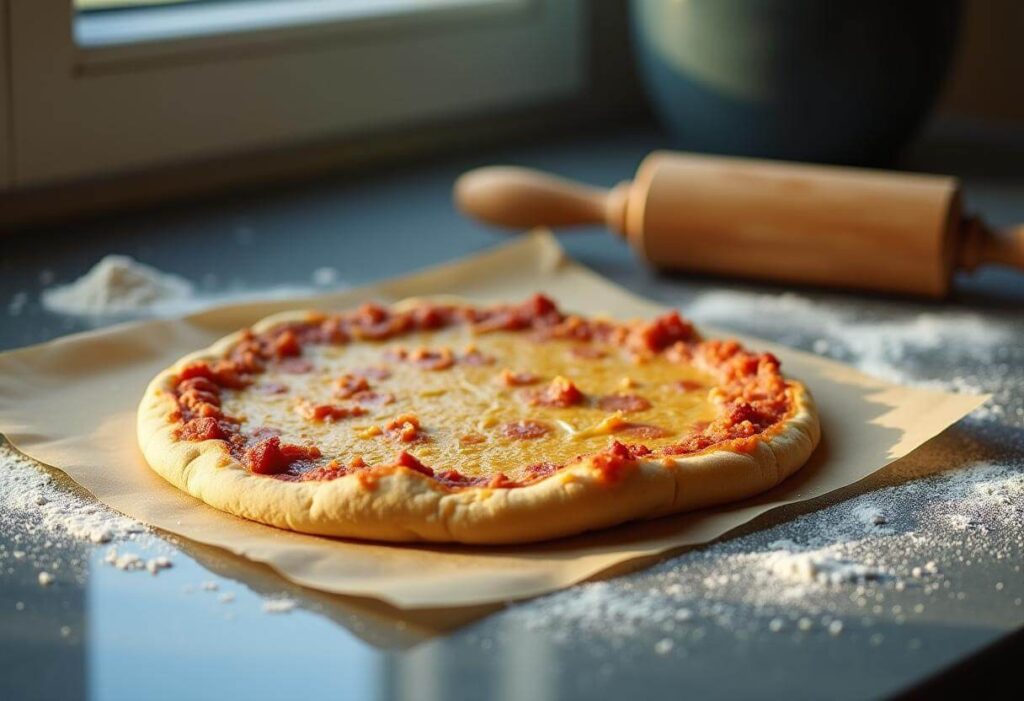
2.1 Preparation Tips
Preparation is the foundation of a great chicken pizza crust. Moisture in chicken is one of the leading causes of sogginess, so handling it properly before cooking is essential.
- Dry the Chicken Thoroughly: Whether using whole chicken or ground chicken, ensure you dry it properly. Use paper towels to pat it dry, removing as much moisture as possible. If using pre-cooked chicken, allow it to cool completely before processing to avoid trapping steam.
- Use Parchment Paper or Greased Surfaces: Chicken crusts can stick to baking trays or pans, making them difficult to flip or remove without breaking. Using parchment paper or greasing your baking surface not only prevents sticking but also ensures even cooking by promoting airflow underneath the crust.
2.2 Cooking Tips
Cooking techniques play a significant role in preventing soggy crusts. Proper heat and timing are key to achieving that golden, crispy crust.
- Ideal Oven Temperatures: Bake your chicken crust at a high temperature, ideally between 400°F and 425°F (204°C–218°C). This ensures the moisture in the crust evaporates while forming a crisp exterior. Lower temperatures prolong cooking time and allow moisture to settle.
- Pre-Bake the Crust: Always pre-bake your chicken crust before adding toppings. A 10–15 minute pre-bake allows the crust to set and develop crispiness. Once baked, let it cool for a few minutes to prevent steaming when you add toppings.
2.3 Using the Right Ingredients
The ingredients you choose can make or break your chicken pizza crust. High-moisture ingredients lead to sogginess, so it’s crucial to select wisely.
- Choose Low-Moisture Cheese and Toppings: Avoid cheeses like fresh mozzarella, which release water when melted. Instead, use low-moisture cheeses such as part-skim mozzarella or cheddar. Similarly, limit the use of raw vegetables that release moisture as they cook.
- Switch to Non-Watery Sauces: Skip traditional tomato sauces that often add unnecessary moisture. Opt for pesto, oil-based sauces, or even a light layer of seasoned ricotta for a flavorful alternative.
2.4 Reheating Techniques
One of the most common challenges with chicken pizza crusts is keeping them crisp when reheating, especially in the microwave.
- PAA Question: How to keep pizza crust from getting soggy in the microwave?
Reheating pizza in the microwave often leads to steaming, which softens the crust. To prevent this, use a microwave-safe crisper tray designed to retain crispiness. Alternatively, place a sheet of parchment paper between the crust and the plate to absorb moisture. - Best Practices for Reheating in an Oven: The oven remains the best option for reheating. Preheat it to 375°F (190°C) and place the pizza directly on a baking rack or pizza stone. This method allows air circulation, ensuring the crust stays crisp while the toppings warm evenly.
By mastering these preventive measures, you’ll be well on your way to consistently crispy chicken pizza crusts. A little extra care in preparation and cooking ensures that soggy crusts become a thing of the past.
3. Fixing a Soggy Pizza Crust
Even with the best intentions, a soggy chicken pizza crust can still happen. But don’t worry—there are ways to salvage it and strategies to ensure it doesn’t happen again.
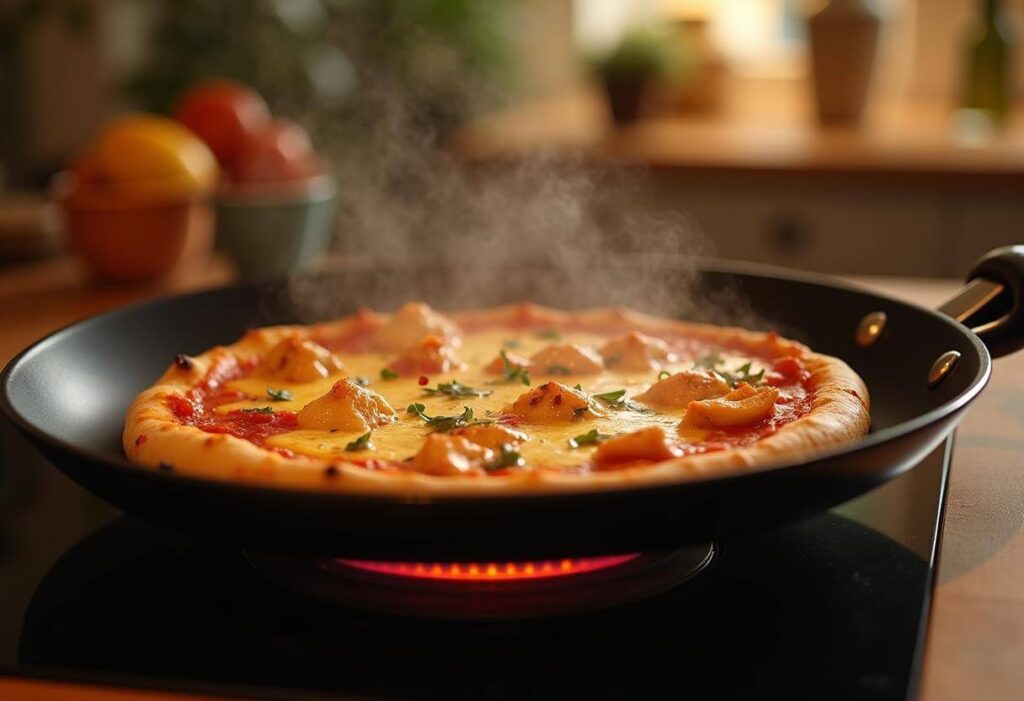
3.1 Immediate Fixes
When your pizza crust comes out soggy, quick thinking can save the day.
- PAA Question: How do you crisp a soggy pizza crust?
If your chicken pizza crust is soggy, the broiler is your best friend. Place the pizza on the top rack under the broiler for 2–3 minutes. The intense heat will evaporate moisture and give the crust a much-needed crisp. Keep a close eye on it to avoid burning. Alternatively, use a non-stick skillet on the stove. Heat the skillet on medium-high and place the pizza crust-side down. Cover it with a lid to trap the heat, and let it cook for 2–4 minutes. This method creates a crispy bottom without overcooking the toppings. - Use a Toaster Oven or Air Fryer: Both appliances are excellent for quickly crisping a soggy pizza crust. Their small size ensures even heat distribution, reviving the texture while reheating the toppings.
3.2 Long-Term Solutions
To prevent soggy pizza crusts in the future, adopting a few foolproof strategies can make all the difference.
- Address Common Mistakes:
- Ensure the chicken is dried thoroughly before forming the crust.
- Pre-bake the crust to set its structure before adding toppings.
- Avoid overloading the pizza with toppings that release excessive moisture.
- Experiment with Different Techniques:
Perfecting your chicken pizza crust may require some trial and error. For instance, you might find that baking the crust longer at a slightly lower temperature helps evaporate moisture more effectively. Alternatively, using a pizza stone or steel can drastically improve crispiness. - Test Ingredient Combinations:
Not all chicken or toppings behave the same. Experiment with different blends of chicken, seasonings, and moisture-absorbing agents like almond flour or parmesan cheese. Track your results to refine your recipe.
By combining quick fixes and long-term strategies, you can rescue soggy crusts and ensure future pizzas come out crisp and delicious every time.
4. Achieving the Perfect Crispy Chicken Pizza Crust
Crafting the perfect chicken pizza crust requires mastering specific techniques and using the right tools. Here’s how to get that golden, crispy crust every time.
4.1 Key Techniques for Crispiness
- PAA Question: What is the secret to a crispy pizza crust?
The secret lies in using high heat and ensuring the crust has the proper thickness. High oven temperatures, ideally between 400°F and 425°F (204°C–218°C), help evaporate moisture quickly and form a crisp outer layer. Preheating the oven for at least 20 minutes is crucial for even heat distribution. Crust thickness also matters. A crust that’s too thick traps moisture, leading to a soggy base. Aim for a thickness of about ¼ inch for optimal crispness and support for toppings.
4.2 Tools for Success
Certain tools can elevate your crust-making game by ensuring even cooking and moisture reduction.
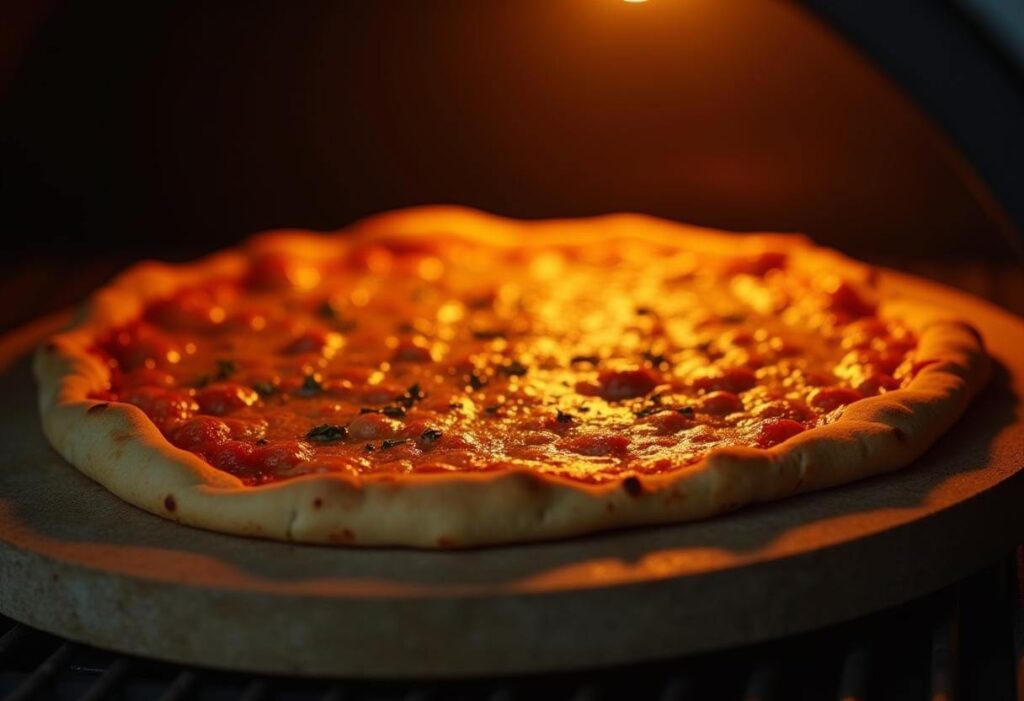
- Pizza Stone or Steel: These tools are game-changers for chicken pizza crusts. They retain and radiate heat evenly, drawing moisture away from the crust and creating a crisp texture. Preheat them in the oven for the best results.
- Air Fryer: The circulating hot air in an air fryer mimics the effect of a convection oven, crisping the crust evenly. Use the air fryer for pre-baking or reheating for an extra crunch.
- Non-Stick Skillets or Cast Iron Pans: Cooking the crust directly on a preheated skillet or cast iron pan before adding toppings helps lock in crispiness. This technique works especially well for small or personal-sized pizzas.
4.3 Recipe Example
Here’s a simple recipe to make a crispy chicken pizza crust at home:
Ingredients:
- 1 lb (450 g) ground chicken
- ½ cup grated parmesan cheese
- 1 egg (optional, for binding)
- ½ tsp garlic powder
- ½ tsp onion powder
- Salt and pepper to taste
Instructions:
- Preheat Oven: Set your oven to 425°F (218°C) and preheat a pizza stone or baking tray.
- Prepare the Mixture: In a bowl, combine ground chicken, parmesan cheese, egg, and seasonings. Mix well until combined.
- Form the Crust: Spread the mixture evenly on parchment paper into a thin ¼-inch circle or rectangle.
- Pre-Bake the Crust: Transfer the crust to the preheated oven and bake for 12–15 minutes or until firm and slightly golden.
- Add Toppings: Let the crust cool slightly, then add your favorite toppings (low-moisture cheese, pre-cooked vegetables, etc.).
- Final Bake: Bake for an additional 8–10 minutes until the cheese melts and the toppings are heated through.
Tips:
- Season the chicken base with herbs like oregano or basil for extra flavor.
- Pair crispy crusts with toppings that contrast textures, like crunchy peppers or creamy cheeses.
By using the right techniques, tools, and recipes, you’ll enjoy consistently crispy chicken pizza crusts every time.
5. Frequently Asked Questions (FAQ)
How to stop pizza crust from getting soggy?
Preventing a soggy pizza crust comes down to proper preparation and cooking techniques:
- Dry Ingredients: Remove excess moisture from chicken or any base ingredients before cooking.
- Pre-Baking: Always pre-bake your crust before adding toppings to lock in its structure.
- Limit Toppings: Use low-moisture cheese and avoid overly wet sauces or uncooked vegetables.
- High Heat Cooking: Bake at a high temperature (400°F–425°F) and use tools like pizza stones or steel to reduce moisture effectively.
By combining these methods, you can prevent sogginess and enjoy a perfectly crisp crust every time.
Why is my pizza dough sloppy?
Sloppy or sticky pizza dough, whether traditional or chicken-based, often stems from improper hydration or ingredient ratios:
- Excess Water: Too much water in the dough can lead to a wet, unmanageable texture. If using chicken, ensure it’s thoroughly dried before mixing.
- Lack of Binding Agents: For chicken pizza crusts, binding ingredients like parmesan, almond flour, or eggs are essential to hold the mixture together.
- Under-Mixing: Mix the ingredients thoroughly to ensure consistency and even distribution of moisture.
If the dough feels too sticky, gradually add a dry ingredient like almond flour or grated cheese until it reaches a workable consistency.
Quick Tips for Managing Moisture and Cooking Tools
- Tools: Use parchment paper for easy removal and a pizza stone or steel for even heat distribution.
- Preparation: Always pat chicken dry before forming the crust.
- Reheating: Use a broiler, skillet, or air fryer to maintain crispiness when reheating.
These practical steps will help you overcome common issues and enjoy better pizza-making results.
Conclusion
A soggy chicken pizza crust can be a frustrating hurdle, but understanding its causes and solutions puts you in control. Whether it’s improper cooking techniques, excessive moisture in the chicken, or overloaded toppings, each issue has a straightforward fix. By addressing these factors, you can consistently enjoy a perfectly crisp crust that enhances your pizza experience.
To prevent sogginess, start by preparing the chicken properly—drying it thoroughly and using the right binding ingredients. Pre-baking the crust, avoiding watery toppings, and cooking at high temperatures are game-changing techniques. And if your crust ends up soggy, quick fixes like using a broiler or skillet can save the day.
Remember, practice makes perfect. Experiment with different preparation methods, tools, and topping combinations to find what works best for you. Don’t hesitate to try out a pizza stone, steel, or air fryer for even better results.
Most importantly, enjoy the process. Making pizza at home is a rewarding experience, and with the tips shared in this article, you’re well on your way to mastering the art of the crispy chicken pizza crust. We’d love to hear about your results, so feel free to share your feedback and experiences. Happy pizza-making!

